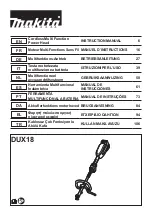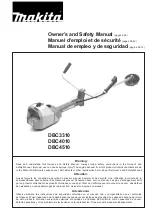
Deutsch
20
VIII
English
Check the device for any problems such as noise or jamming of
moving parts that could be affecting the device.
Check the device, jaws and crimping dies and cutting blades for
cracks and other signs of wear before each use.
Clean and grease the devices when you have finished work.
Clean and grease the drive rolls, the locking boldt and jaws.
Check that the jaws can move freely.
Replace the crimping dies and cutting blades when they become
chipped or damaged.
Check that the cutting edges are sharp and replace worn cutting
blades.
Always replace crimping dies and cutting blades as a set.
The ventilation slots of the device must be kept clear at all times.
To avoid injury and damage, never immerse the device, removable
battery or charger in liquid or allow liquid to penetrate them.
Further service and repair work may only be carried out by authori-
sed specialist workshops.
The device contains hydraulic fluid. Hydraulic fluids pose a hazard
to groundwater. Uncontrolled draining or improper disposal is
punishable by law.
The next service deadline is indicated by LED on the device.
This service must be performed at least every 2 years or after
30,000 crimping operations or at the latest when the LED display
indicates that a service is due.
Use only Milwaukee accessories and Milwaukee spare parts. Should
components need to be replaced which have not been described,
please contact one of our Milwaukee service agents (see our list of
guarantee/service addresses).
If needed, an exploded view of the tool can be ordered. Please
state the Article No. as well as the machine type printed on the
label and order the drawing at your local service agents or directly
at: Techtronic Industries GmbH, Max-Eyth-Straße 10, 71364 Win-
nenden, Germany.
ONE-KEY™
To learn more about the ONE-KEY functionality of this device,
please refer to the Quick Start guide included with this product or
go to http://www.milwaukeetool.com/one-key
To download the ONE-KEY app, visit the App Store or Google Play
from your smart device.
We considered the result to be within our minimum acceptable per-
formance level according to EN 301 489-1/ EN 301 489-17. And we
will give the operation guidance to the customer in user manual.
BATTERIES
Battery packs which have not been used for some time should be
recharged before use.Temperatures in excess of 50°C (122°F) reduce
the performance of the battery pack. Avoid extended exposure to
heat or sunshine (risk of overheating).
The contacts of chargers and battery packs must be kept clean.
For an optimum life-time, the battery packs have to be fully
charged, after use.
To obtain the longest possible battery life remove the battery pack
from the charger once it is fully charged.
For battery pack storage longer than 30 days: Store the battery
pack where the temperature is below 27°C and away from moisture
Store the battery packs in a 30% - 50% charged condition Every six
months of storage, charge the pack as normal.
Do not dispose of used battery packs in the household refuse or
by burning them. Milwaukee Distributors offer to retrieve old
batteries to protect our environment.
Do not store the battery pack together with metal objects (short
circuit risk).
Battery acid may leak from damaged batteries under extreme load
or extreme temperatures. In case of contact with battery acid wash
it off immediately with soap and water. In case of eye contact rinse
thoroughly for at least 10 minutes and immediately seek medical
attention.
No metal parts must be allowed to enter the battery section of the
charger (short circuit risk).
TRANSPORTING LITHIUM BATTERIES
Lithium-ion batteries are subject to the Dangerous Goods Legisla-
tion requirements.
Transportation of those batteries has to be done in accordance with
local, national and international provisions and regulations.
The user can transport the batteries by road without further
requirements.
Commercial transport of Lithium-Ion batteries by third parties is
subject to Dangerous Goods regulations. Transport preparation and
transport are exclusively to be carried out by appropriately trained
persons and the process has to be accompanied by corresponding
experts.
When transporting batteries:
Ensure that battery contact terminals are protected and insulated
to prevent short circuit. Ensure that battery pack is secured against
movement within packaging. Do not transport batteries that are
cracked or leak. Check with forwarding company for further advice
EC-DECLARATION OF CONFORMITY
We declare under our sole responsibility that the product described
under “Technical Data” fulfills all the relevant provisions of the
directives
2011/65/EU (RoHS)
2006/42/EC
2014/53/EU
and the following harmonized standards have been used.
EN 62841-1:2015
EN 62479:2010
EN 55014-1:2017+A11:2020
EN 55014-2:2015
EN 301 489-1 V2.2.3
EN 301 489-17 V3.1.1
EN 300 328 V2.2.2
EN IEC 63000:2018
Winnenden, 2020-11-10
Alexander Krug / Managing Director
Authorized to compile the technical file
Techtronic Industries GmbH
Max-Eyth-Straße 10, 71364 Winnenden, Germany
Содержание M18 HUCT
Страница 1: ...Original instructions M18 HUCT...
Страница 4: ...2 I 1 2 1 2 3...
Страница 5: ...3 I TIP 78 100 33 54 55 77 10 32 10...
Страница 7: ...5 III 4 START LED LED xxx 1 340 340 2 3 90 90...
Страница 8: ...6 III Auto Stop 5 A 2 2 3 1 6 A...
Страница 9: ...7 III 2 2 3 1 Auto Stop 5 B 6 B...
Страница 10: ...8 III 2 3 3 4 1 STOP 5 C 6 C...
Страница 11: ...9 1 2 3 III TIP...
Страница 12: ...10 350 IV 2 90 90 1...
Страница 13: ...11 IV 3 START LED LED Auto Stop 4 A...
Страница 14: ...12 IV 4 B 5 B STOP 2 4 3 3 1...
Страница 15: ...13 V 1 3 2...
Страница 16: ...14 VI REPORT...
Страница 17: ...15 VI 1 3 4 2 3V CR2032...
Страница 18: ...16 VII Service...



































